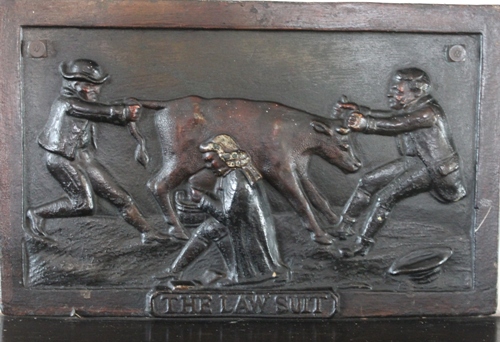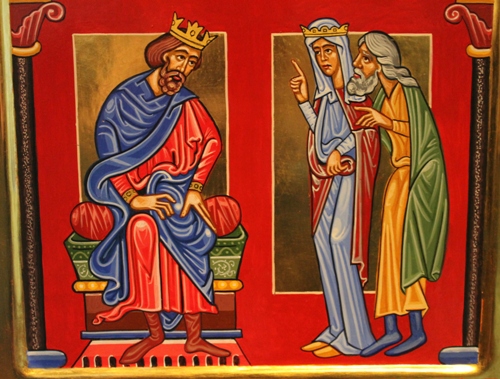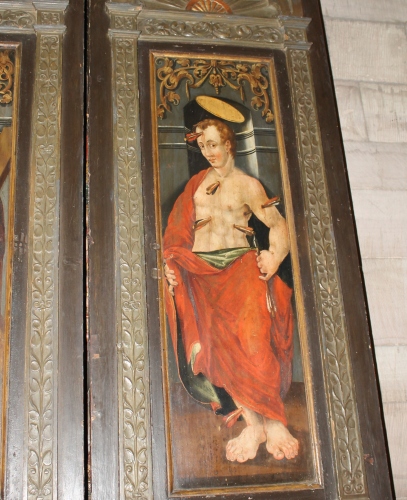The thing I really love about Hereford is the centre of town. It is called Old Town and there are no cars, no buses, no vehicles of any kind. It is all pedestrianised, just the way it really should be in Farnham but isn’t because the car drivers hold sway over everyone else. Apparently they enjoy breathing foul, fume laden air.
Today there was a market throughout the centre and the atmosphere was wonderful. No foul fumes for one thing. Smiling people going from stall to stall; fresh fruit, veg, meat, Persian pastries, all sorts of things. There’s also an indoor market for those who wish to shop under cover. All delightful. We loved it.
We loved it so much, we stopped for a latte in the centre and watched the people skipping and whistling along the thoroughfares, completely delighted at the lack of cars (and other vehicles).
But there were tourist things we needed to do so we popped along to the Old House which stands at one end of the Old Town at the end of what was once called, Butcher’s Row. This should not be meant to imply that it was an entire street full of butchers. The street has had many different names down through the ages. But there is some thinking that the Old House once belonged to a butcher called Jones.
He may have had a wife who was a bit noisy and a big drinker. She was also somewhat free with her pigs, letting them wander off all over the place. Her name was Mary and she was also a bit of a scold…or so the Lawday court record for 1625 shows.
The rest of Butchers Row was demolished a long time ago, mostly, it seems by the Paving, Repairing, Cleaning and Lighting Commissioners of Victorian Hereford. According to the minutes of a meeting of said commissioners:
“…it is the opinion of this meeting that the old buildings…of Butchers’ Row, are a great annoyance, and that it would add much to the ornament and convenience of [Hereford] to take the said buildings down…”
Most of the houses were, in fact, pulled down but for reasons unknown, the Old House was left standing. The guide book claims it may have been because of a “…particularly resistant tenant.”
These days it’s a museum to the house or the general period of the house. There’s some great bits and pieces of very old furniture dotted throughout the three floors. My favourite was this rather odd thing. It’s a small iron picture called ‘The Law Suit’.
I think the idea is that the plaintiff has the head and the defendant the tail but the lawyer gets the cream all the time, meaning the lawyer wins regardless of who loses. Cute.
There’s also some wonderful paintings which have been removed from another building. They depict a whole load of Greek muses, including Calliope, my personal favourite.
In fact, Mirinda is my Calliope. Many years ago I wrote a play about my method of directing and the director in it had an assistant modelled on Mirinda and her name was Calliope. She is the muse of epic poetry but I just like the name.
The house is arranged in, more or less, the domestic arrangements of the 17th century but no-one is really sure and I noticed there wasn’t a bathroom or kitchen. Part of the ground floor would have been a shop and, the guide book thinks that cooking may have been “…undertaken in one of the main rooms in front of the hearth.”
Talk of bathrooms puts me in mind of the shower at the B&B we are staying in. The pressure is great, the temperature is fine, the shower head is like a waterfall so that’s even good. The only problem with the shower (and I’ve noticed this sort of thing before) is working out how to make the water come out.
The tap does not control the water, it controls the temperature. The lever is what controls the water. There is a second tap that controls the water to the second shower head but this will only work if the lever is turned on first. Once it was all worked out, the shower was great but, really, how hard would it be to supply instructions with simple diagrams. All guest bathrooms are different and none are like the ones at home.
After the Old House, we wandered down to the cathedral. It’s a lovely small cathedral, squat and welcoming. There is a lot of colour spread around the place, giving it more warmth and making it less foreboding. This is my kind of cathedral!
It is dedicated to Mary the Virgin and St Ethelbert the King. Now it’s really important not to confuse this Ethelbert with the famous one from Canterbury who was the first Anglo-Saxon king. This Ethelbert was from East Anglia and for political reasons was murdered by Offa in around 794AD.
Of course, Hereford’s Ethelbert is celebrated in a much more colourful and exciting way than I have just written above. There is a collection of thirteen panels, painted by Peter Murphy which tell his life much better than I could.
The story of Ethelbert, in a nutshell, is as follows:
He’s born. He’s crowned king of the East Angles at age 14. He decides to go to Mercia. On the trip there’s an earthquake and the sun goes dark. A singer gives him a bracelet and sings of Ethelbert’s royal lineage. Ethelbert has a vision. He is spotted by his bride to be.
There are rumours about Ethelbert which makes him out to be not very nice. Offa has him beheaded. Someone throws his body in the river but it is subsequently fished out and sent by ox cart to Hereford. Along the way, the head rolls off the cart and falls back into the river.
A blind man happens along and finds the head. When he retrieves the head, his sight is restored. This starts a lot of people off, coming to the spot to be healed. The cathedral is built.
Ignoring the silly story, the pictures are exquisite and a good indication of how church art would have looked originally: Very bright and cheerful.
The thing that Hereford cathedral is best known for is the mappa mundi. This is a medieval map of the world, on vellum or calf’s skin. It is the largest mappa mundi still in existence and therefore, priceless. There are others dotted around the world but this is the one everyone knows.
I’ve wanted to see it since first hearing about it years ago. While I’ve seen lots of images and read lots about it, nothing is quite like seeing the real thing.
It was created some time around 1300 and no-one knows why or by whom. There, obviously, have been a few guesses but the truth will no doubt never be known.
The map is round and shows the known world of the time. Dotted around the edge are mythical creatures of strange and horrific proportions with added (or subtracted) body parts – you really can’t imagine a man without a head, his eyes and mouth in his chest, until you see it.
Of course, it is so old, that you cannot take photographs of it. It sits in its hermetically sealed, glass fronted box, in a darkened room as people file passed, giving homage.
Beyond the map is the chained library. Back in the medieval days, priests couldn’t be trusted to return library books so, rather than introduce fines to an order of chaps who had given up all that sort of worldly goods nonsense, they would attached chains to the books so they couldn’t go any further than the desk. I find it very interesting that people of a godly and Christian nature couldn’t be trusted around a load of books…maybe that’s just me.
Of course, even the mappa mundi fades into insignificance when I find a St Sebastien…which I did. There’s no explanation of who, what, why or when so I can only guess. It looks a bit German and a bit old although the body and face of St Seb have a rather comic feel about them. And rather big feet.
We had a coffee in the church cafe where I overheard a woman telling four separate people how it had suddenly poured down with rain and then it has stopped and the blue sky was back. This was while we were in the cathedral. Sounds about perfect to me.
This happened again when we walked back to the B&B. As we were sitting in the room, the windows were suddenly lashed by water and wind. How lucky were we?
Anyway, lunch today was at Ask, where we were entertained by an 8 year old girl who was out, celebrating her birthday with a bunch of her contemporary friends. I’m really surprised how fast kids grow up these days. Eating out at 8. Amazing.
I had a lovely belly of pork on new potatoes, which was delicious except for the fact that there were about 12 potatoes. I mean, seriously, who is going to eat that many potatoes? I generally have about three new potatoes with a meal. So it’s not so strange that I left nine this time. Still, while it was somewhat overrun with spuds, it was delicious and the pork just melted in my mouth.
I almost forgot. As we were walking by the public library, Mirinda found a platypus. All around the entrance was a series of little animals, carved into the arch of the opening and one of them was a platypus! Very unusual. Most people in this country have no idea what one is. In fact, you tell them about the platypus and they think you’re pulling their legs.








Only just got around to reading your blog’s all very interesting and love the photo’s I have never been to Hereford but dad thinks he might have passed through.
love mum